OC 44: The Street: Bastion of Open Cities?
What is an open city? How does it manifest itself? When people walk through the city they experience it through its ground floor: the street, the pavement, the green, but also how buildings relate to these spaces. Within a stone throw, a city can send many contradictory messages to passers by from its ground floor. Some places still contribute to an open city. They invite passers by in, attract their glances, include them. Others turn their back on them, close their doors and windows on them, make them unwelcome.
Fear of crime is cultivated relentlessly, not only by the security industry but also for political reasons, creating a climate of mistrust against the other, the unknown, often the unwanted. These feelings are slowly translated into the physical fabric of the city.
Sadly, many younger people have never experienced genuine city openness. They have never walked into a public building without being searched. Similar screening are becoming common place in many private premises used by the public. A security guard is standing in the doorway of every department store, every supermarket or bank and are a common picture in many places which people use in their everyday pursuits. Residential quarters are refurbishing their railings and setting up gateways with entry-phones, codes, other barriers to exclude all but those who are selected and accepted.
It is still possible to step into smaller shops unhampered. Traders continue to sell their wear in street markets, but even there, the ground is compartmented, allocated, controlled, sometimes gated.
When new buildings replace the ones on traditional high streets they instate ‘blind’ windows letting those from within look out but preventing passers by to see in. Some use the ground floors for gated car parks with bleak walls towards the street, sometimes with some decorative devices acting as a softer screen. Others brick up ground floor openings and many of them install private CCTV. Slowly, assisted by urban regeneration and annexation of semi-private space a gulf is emerging between public realm and adjacent private uses. The streets become lifeless.
A lot of research has been dedicated to the effects of ‘inactive’ ground floors to city life, not least by Jane Jacobs http://en.wikipedia.org/wiki/Jane_Jacobs whose writing is enjoying a revival. This does not prevent the property market to pursue a ‘safety’ policy, distancing or isolating real estate from the surrounding public realm, not least by annexing public realm into their portfolio.
Are people using streets less? Are they staying more indoors, remaining in their suburbs, using the internet to get their supplies delivered behind safe barriers? Not yet it seems. To date, public transport remains filled to the hilt in many cities. People still commute to their workplaces, still walk the city to get their lunch sandwiches, still sit on park benches where they have not been taken off for security reason, as well as waste baskets and other user friendly street furniture. Streets in cities are still open to people, despite Manuel Castells’ http://en.wikipedia.org/wiki/Manuel_Castells conclusion in “The Urban Question’ that “…urban social movements … have their birth … in every day facts, …issuing new challenges, in a cry for life… A cry that is a strong reminder that urban power, too, lies in the streets (p 378).”
Is it not surprising therefore, that the same forces which are privatising the public realm demand to enter the private realm of everyone of us by getting access to every form and every place where we communicate with our fellow citizens? See comments on the proposed legislation on Internet surveillance ‘The Snoopers’ Charter’ in the UK e.g. http://www.panopticonblog.com/2012/04/05/internet-surveillance-a-snoopers-charter/ and http://news.bbc.co.uk/1/hi/uk/3104054.stm

8-dia surveillance: variations on a theme source: http://snippits-and-slappits.blogspot.co.uk/2010/06/through-wormhole-ss-mad-scheme-to.html
Maybe, as Castells affirms after the failed May ’68 dream, what is left of the street is where urban power still lies, where every urban passer by can still exercise freedom of exchange with any other, with each one of us who is still using the public realm as part of our everyday life.

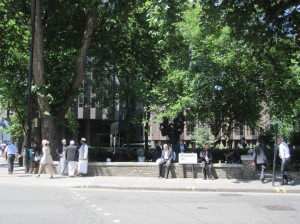
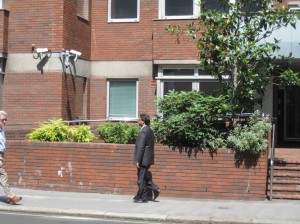
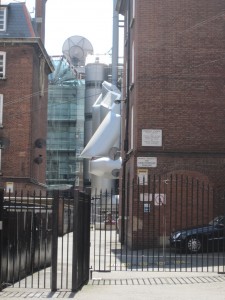
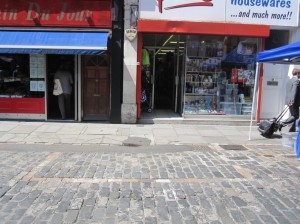
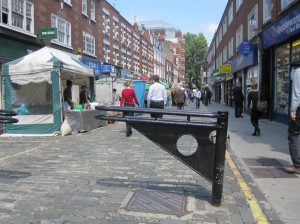
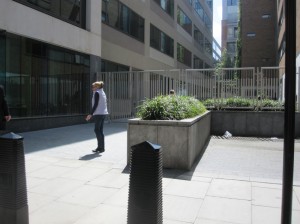
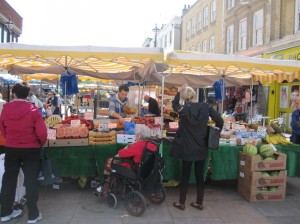
I used to work in the Cotton Centre – a relatively open plan office building on the South Bank, just next to Hay’s Wharf and between London Bridge and Tower Bridge.
I think that one of the nice things about it is that anyone can just walk in off the street or plaza and enjoy the small jungle of plants on the Ground Floor of the building. They can sit on the low walls and eat their lunch with nobody asking them to leave – particularly great if it is raining…..
There are sometimes exhibitions there – usually of paintings or photographs – that also invites people to come inside the building.
You can also walk across the Ground Floor to take a short cut from the river terrace to the road behind the Cotton Centre or go downstairs to walk through a tunnel that come out close to London Bridge itself. You can also go up a short staircase and across a covered bridge to avoid the busy road and get into London Bridge station.
The Cotton Centre seems a very inviting building and seemingly tries to include all – not just the people who work there but outsiders as well. It helps to prevent the office workers getting too insular and reminds tourists that others are working whilst they sightsee.
The architects of the Cotton Centre seem to have taken many views into account and this might qualify for an open building award……
The postcode of the Cottons Centre in London is:
SE1 2QP……..enjoy……
Thank you for this very nice tip. It is good to know that some companies do care about the public realm and make it inviting for people to enjoy.